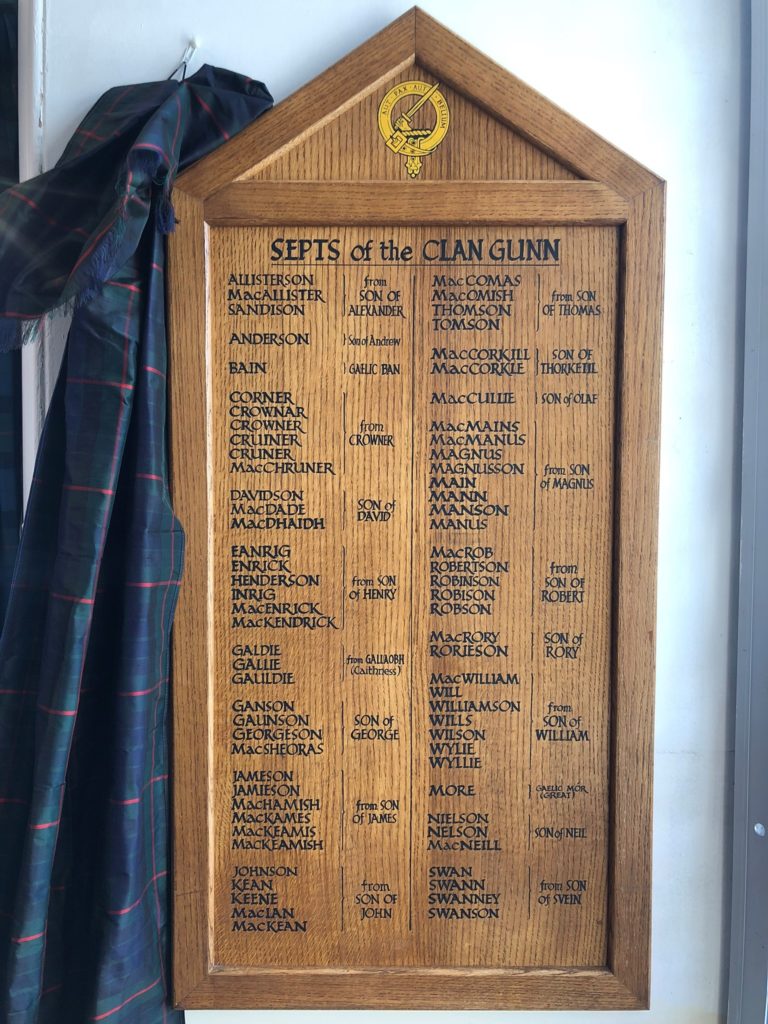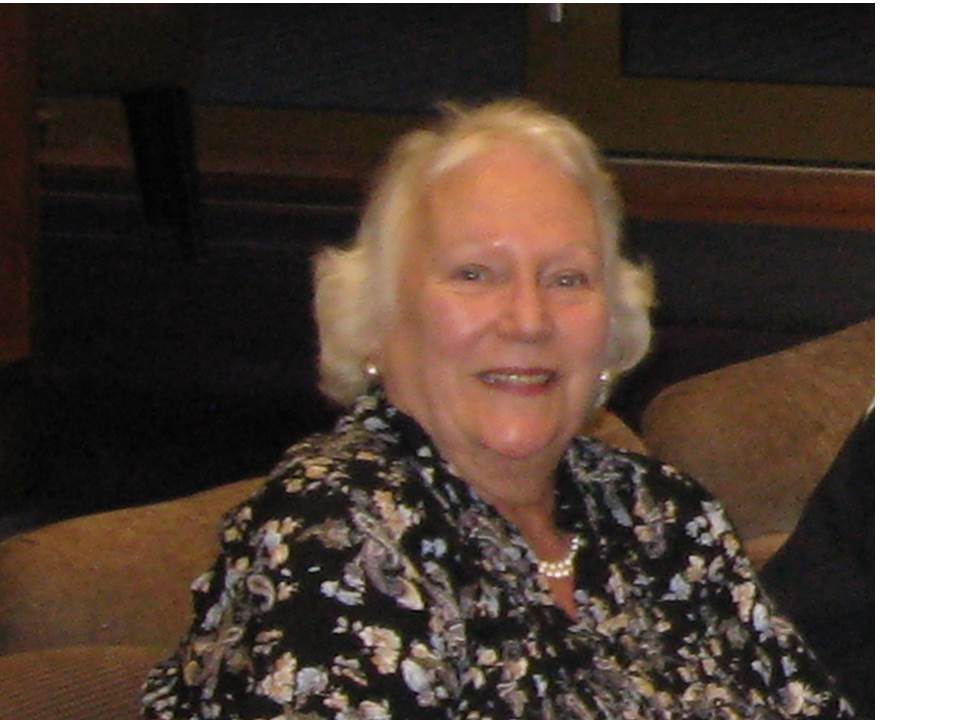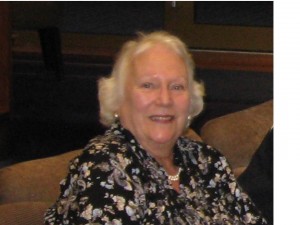References taken from The Clan Gunn and Its Country, published by the Clan Gunn Heritage Center, Latheron, Caithness and The History of the Clan Gunn by Mark Rugg Gunn which are the documents the Committee have seen as our Official History. References will be given where possible but understand history from earlier periods was often from word of mouth or ballads which are open to interpretation and bias.
Gunn Clan Crest: An arm attired in the Gunn tartan with the hand grasping a basket hilt sword.
Gunn Clan Motto: Aut Pax Aut Bellum (Either peace or war).
Early Days
The Clan Gunn claims direct descent from Gunni, grandson of Sweyn Asleifsson, the “Ultimate Viking” and hero of the Orkneyinga Saga.
Clan Gunn is also descended from the Norse “Jarls”, or Earls of Orkney through Gunni’s wife Ragnhild, who was grand-daughter and eventual heiress of St. Rognvald, Jarl of Orkney. Through Ragnild’s father Erik Staybrails the senior heir of Moddan of Dale, the Clan also descends from Moddan of Dale and the ancient Mormaers or High Stewards of Caithness
The name originated from a Norse personal name “Gunni” (which means “war”). The first Gunni came to Caithness at the end of the 12th century when his wife inherited land there from her brother who was Jarl (Earl) of Orkney. Gunni’s wife was descended from St Ragnvald who founded the St Magnus Cathedral in Kirkwall. Gunni’s Viking grandfather had been killed in 1171 on a raid on Dublin. Orkney, Shetland and Shetland were still part of Norway at this time.
Gunni’s wife Ragnhild, who inherited great estates in Caithness and Sutherland in 1198 on the death of her brother Harold Ungi, Jarl of Orkney and Caithness. These lands were inherited by Snaekoll, Gunni’s son, the second chief of the Clan.
Although Ottar, a descendant of Gunni, is known to have lived around 1280 and is the assumed progenitor of the Gunn chiefs, . A number of separate lines of Gunns became established in Braemore (known as the Robson Gunns), Killearnan, Kildonan and also the Caithness Hendersons and Williamsons.
1200 onwards –
By the thirteenth century the Gunns were at the height of their powers and appear to have possessed the whole of Caithness.
There is some interesting evidence to indicate that Sir James (Seamus) Gun, Chief of the Clan Gunn, may have accompanied Henry Sinclair of Orkney on his reputed expedition to the New World, some ninety years before Columbus claimed to have discovered America.
An effigy of a mediaeval Knight in armour, reputed to be Sir James (Seamus) Gun is cut into a rock face at Westford, Massachusetts. Link to museum HERE
1400 onwards –
The first Chief of the Clan to be recorded with certainty was George (Seoras) Gunn who was the coroner of Caithness in the 15th century. He was known as “Am Braisdeach Mor” or “the great brooch-wearer” from his insignia as coroner.
He had a castle at Clyth on the east coast of Caithness. During the fourteenth and fifteenth centuries (during an preceding George’s time) there were many skirmishes between the Gunns and their neighbours the Sinclairs, the Keiths and others who had obtained grants of land from the Scottish Kings, anxious to increase their influence over the fringes of their kingdom.
As a result the Gunns were gradually disposed of their lands in the more fertile parts of Caithness. By the mid fifteenth century George the Crowner of Caithness held his main lands at Ulbster and Clyth. He established his main seat at Halberry Head on the East Coast of Caithness, a mile south of Snaekoll, Gunni’s son’s Castle at Bruan.
The Gunns became established in the highland areas of Caithness and they were frequently in conflict particularly with the clan Keith. The source (excuse?) for the feud was said to have been when Dugald Keith, who had been spurned by Helen, a daughter of Gunn of Braemor, surrounded her home, reportedly at her wedding to Alexander Gunn son of Lachlan Gunn, killed a number of the inhabitants and carried her back to Ackergill Castle. Helen then threw herself from the tower there rather than submit. It’s said her ghost still wanders Ackergill Tower to this day! A ballad written by LL Andrews can be located if you CLICK HERE
Times that followed were filled with war. Much blood was shed and neither Gunn nor Keith could continue this way.
Around 1478, although 1464 and other dates have been mentioned in other scripts, a meeting was appointed for their reconciliation, at the Chaple of St. Tayre, in Caithness, hard by Girnigo, with twelve horse on either side. The Crowner (George, chieftain of Clan Gunn) with the most part of his sons and chief kinsmen came to the chapel, to the number of twelve; and, as they were within the chapel at their prayers, the Laird of Inverugie and Ackergill arrived there with twelve horse, and two men upon every horse; thinking it no breach of trust to come with twenty-four men, seeing they had but twelve horses as was appointed.
The twenty-four Keith party rushed in at the door of the chapel, and invaded the Crowner and his company unawares; who, nevertheless, made great resistance. In the end the Clan Gunn slain included The Chief , with the most of the Keiths.
The book Conflicts of the Clans, written in 1764, has this to say; “Their blod may be seen to this day upon the walls within the Chapel at St. Tyre, where they were slain.” St Tayre chapel no longer stands.
Interesting reading and links can be found offsite HERE
William, the grandson of the murdered chief was the first to hold the title “MacSheumais Chataich” (son of James of Caithness, his father).
Stories exist that the surviving Gunns tracked the Keiths and killed them on the road from Inverugie. Other stories tell how the surviving sons (and likely grandsons) made an attack on Dirlot Castle as the Keiths drunkenly celebrated their victory. Taking out the guards with longstaffs and shooting bows through the open windows, the small vigilante party were able to even the loss and reclaim their dead Chief’s brooch.
With the death of the Crowner and his sons at Ackergill, the Clan split into three main branches.
James, (Seamus) the eldest, was absent in Sutherland and heard of the tussle later (reference from the papers of Sir Robert Gordon).
Robert and John were killed but left issue (decendants).
William and Henry as we will see later survived.
The fate of Torquil and Alexander is doubtful; Torquil seems to have survived for a time but he fades out of history, and he may have died of wounds later. Alexander may have been killed but he left behind him descendants.
James, (Seamus) the Crowner’s eldest sosettled in Kildonan, Sutherland where he obtained lands from the Earl of Sutherland.
Robert’s line established his line in Braemore in the Southern heights of Caithness as Robson or Caithness Gunns. John’ the third surviving son,’s decendents established their own line and settled in Cattaig in Strathmore in the higher reaches of the River Thurso near Westerdale.
Treaty – In 1978 the Earl of Kintore, Chief of Clan Keith, and Iain Gunn of Banniskirk, Commander of the Clan Gunn signed a Treaty of Friendship between the two Clans at the site of the Chapel, thus bringing to an end a five hundred year old feud.
In 1586 the Sinclair Earls of Caithness and the Gordon earls of Sutherland agreed a pact to destroy the Clan Gunn and in order to strengthen their position Gunn of Killearnan married the sister of the chief of the clan Mackay. However, the lands of Killearnan were not lost through battle but by debt. They later obtained land at Badenloch and tried to establish themselves with all the accoutrements of a Highland chief.
In the 17th century, Sir William Gunn who was a brother of the Robson chief, rose to be a battalion commander in the service of the king of Sweden and then fought for King Charles I who gave him a knighthood in 1639. He later married a German baroness and became an imperial general in the Holy Roman Empire.
The Gunns, as a Clan, did not become involved in the 1715 Jacobite Uprising and when Bonnie Prince Charlie raised his standard in 1745 the Gunns fought on the side of the Hanoverian government.
Gunns did independently fight for the Bonnie Prince and a list can be found in the publication No Quarter Given, the muster roll of Prince Charles Edward Stuart’s Army 1745–46.
The Gunns suffered greatly as a result of the Highland Clearances in the 19th century and many emigrated or were forced to move to other areas of Scotland.
Modern Day –
In 1960 the current Clan Gunn Society was established and has been a great source of information for Gunn and Sept decendants worldwide as well as organising some excellent Gatherings and visits.
On September 25, 2015, the Lord Lyon King of Arms for Scotland issued an interlocutor recognizing Iain Alexander Gunn of Banniskirk as Chief of Clan Gunn. He is now Iain Alexander Gunn of Gunn, Chief of Clan Gunn. At a Family Convention, held in Orkney on July 18, 2015, a petition to the Lyon Court requesting this recognition was approved and sent to the Lyon for action. For the first time in 230 years the Clan has a recognized Chief. Iain previously served as Commander of Clan Gunn for over forty-three years . Further details can be found here
In modern times the novelist Neil M Gunn wrote many books based on his childhood on the coast of Caithness.
The Gunn clan motto is “Aut Pax Aut Bellum” which means “Either peace or war”.
The Clan Gunn Society Membership List gives no less that 77 names “recognised as being associated with Clan Gunn, but the list given in Frank Adam’s “The Clans, Septs and Regiments of the Scottish Highlands”, revised by Sir Thomas lnnes of Learney is much shorter. This is the list the Chief and Council recognise and consists of;
Gallie – Georgeson – Jameson – Johnson – Keene – MacCorkill – Maclan -MacKeamish – MacRob – Manson – Robison – Sandison – Williamson – Gaunson – Henderson – Jamieson – Kean – MacComas – MacCorkle -MacKames – MacKean – MacWilliam – Nolson – Robson – Swanson – Wilson
These are nearly all derived from the sons or descendants of “the Crowner”-James, John (or Ian). Henry. Robert, William and George. Gaunson is Gunn’s son,Manson is Magnus’ son, Swanson is Sweyn’s son, Nelson is Neil’s son and Sandison is Alexander’s son.
The ‘Macfl‘hor-Ketils’ are mentioned as belonging to the Clan Gunn in a feud with the Mackays.
Surnames regarded as possible derivatives of Septs of Clan Gunn or affiliated with Clan Gunn include Anderson — Enrick — Galdie — Gallie — Ganson — Gauldie — Gaunson — Georgeson — GUNN — Henderson — Inrig — Jameson — Jamieson — Johnson — Kean — Keene — MacCorkill — MacCorkle — MacCullie — MacIan — MacKames –MacKeamish — MacKean — MacMains — MacManus — MacOmish — MacOomas — MacRob — MacWilliam — Mangus — Main — Mann — Manson — Manus — Neilson — Nelson — Robinson — Robson — Robison — Sandison — Swan — Swanney — Swanson — Will — Williamson — Wills — Wilson — Wylie — Wyllie.
This photograph of the Sept names in the Heritage Centre reflects some of those variations.

While the onus would be on the applicant to show lineage to the original sept list we understand names were changed, shortened, translated from Gaelic and misspelled at many times in history. There may be other derivatives out there!
Gunn is still one of the top twenty surnames in the Highland region of Scotland according to the General Register Office.
References taken from The Clan Gunn and Its Country, published by the Clan Gunn Heritage Center, Latheron, Caithness and The History of the Clan Gunn by Mark Rugg Gunn which are the documents the Committee have seen as our Official History. References will be given where possible but understand history from earlier periods was often from word of mouth or ballads which are open to interpretation and bias.


